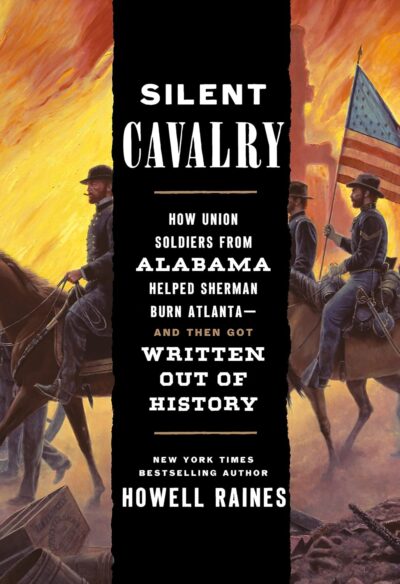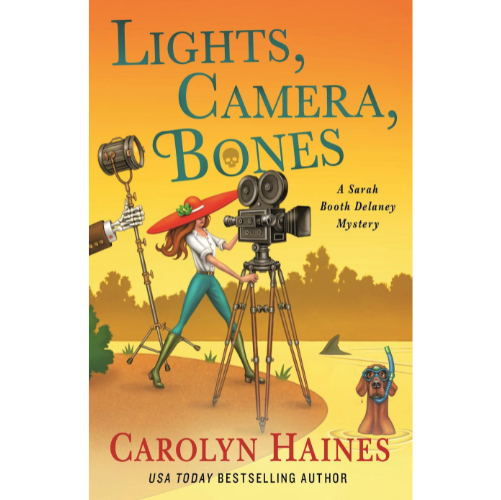By Howell Raines
Crown/Penguin Random House, 2023
Hardcover, $36
Genre: History/Family History
Reviewed by Richard Kent Evans
The idea to write Silent Cavalry first occurred to Howell Raines when he was a boy in the 1950s. His grandmother, Martha Jane Best Raines, was relaying to her grandson tales of the “hillbilly rivalries” that occupied the closing decades of the nineteenth century. To Howell’s surprise, she said, “Oh shit, here comes one of those damn democrats.” That his God-fearing grandmother would utter such profanity left a lasting impression on the young Howell and began a lifelong journey to learn more about the families from which he descended, and about the role they played in the Free State of Winston and Alabama Unionism.
The tension between Grandma Raines and her neighbors points to a phenomenon that defies the Heart-of-Dixie stereotype so prevalent in the minds of many Alabamians: poor whites living in the hill country in the northern third of the state were not only ambivalent about turning traitor against the United States in defense of the southern slaveocracy, they outright resisted it . They declared their succession from the newly seceded State of Alabama, fled Confederate conscription efforts, and sabotaged the Confederate war effort. Some Alabama Unionists went so far as to enlist in the First Alabama Cavalry—a unit composed of north Alabama hillbillies who fought bravely against Confederate forces in Alabama, Georgia, and Tennessee, and played a major role at General Sherman’s right hand in burning Atlanta and bringing the awful war to a close. This fascinating history—and the equally important story of how this history has been buried and misremembered—is the subject of Howell Raines’s latest book, Silent Cavalry: How Union Soldiers from Alabama Helped Sherman Burn Atlanta—and Then Got Written Out of History.
Howell Raines knows a good story when he sees one: his Pulitzer-Prize winning career began in 1964 when he joined the Birmingham Post-Herald fresh out of Birmingham Southern. After stints at WBRC-TV, Tuscaloosa News, and The Birmingham News, Raines joined the New York Times in 1978 as a national correspondent. By 2001, he was executive editor, leading the Gray Lady through one of our nation’s most turbulent eras. Raines has been wildly successful outside of journalism as well. His debut novel, Whiskey Man (1977), was a hit with both readers and critics, and his 1993 memoir Fly-Fishing Through the Midlife Crisis was a bestseller. These and other accomplishments earned Howell Raines an induction into the Alabama Writers Hall of Fame.
For those unaware of the history of Alabama Unionists, Silent Cavalry is a fine place to start. Readers will be introduced to the charismatic Alabama Unionist Chris Sheats, a schoolteacher-turned-leader of an underground resistance movement. He inspired thousands to flee Confederate conscription by hiding out in the caves in the bluffs along the Sipsey River, to bear the threat of roving bands of rebel terrorists, and, for those who would compose the First Alabama Cavalry, to navigate the Indian trails between the Appalachian foothills and the Tennessee River, where they could reach Union lines and enlist. Raines, using both original research and existing scholarship, demonstrates the First Alabama Cavalry’s crucial role in the later parts of the war and gives the lie to the claims of earlier historians who downplayed the unit’s importance and sometimes simply ignored its accomplishments.
But the history the First Alabama Cavalry, and of “hillbilly” opposition to secession and to the Confederacy, is not all that interests Raines. The bulk of this 500-page book deals with the fascinating story of how the First Alabama Cavalry was written out of history. In telling this story, Raines introduces us to a number of colorful villains who devoted their careers to distorting history of the Civil War in the name of white supremacy, none more memorable than Marie Bankhead Owen, the little old lady who ran the Alabama Department of Archives and History for over thirty years. Her qualifications for the job were that she was the widow of the archivist who had founded it and that—on account of being a Bankhead—she was well connected politically. Throughout her over thirty-year career, which included hosting a young Howell Raines on a school field trip, Miss Marie ensured that whatever history she didn’t like was simply destroyed or at least locked away. Raines tells us about a team of ladies who worked for Miss Marie whose job it was to cut out articles about Alabama from national periodicals and paste them onto sheets of paper, throwing away, of course, any articles that put the state in a negative light. Readers will recognize in Miss Marie’s actions the same aww-shucks authoritarianism behind our state’s efforts to ban discussion of “divisive concepts” in schools.
Silent Cavalry is at its most effective as a beginner’s guide to Civil War historiography. There has been a great deal of public interest lately in writing and teaching the history of the Civil War and Reconstruction, much of it driven by the darker forces in our political landscape. In the 1860s, no one misunderstood that the central cause of the Civil War was slavery. Those who fought under the stars and bars of the Confederate Battle Flag fought for a regime founded upon, as they saw it, “the great truth that the negro is not equal to the white man; that slavery subordination to the superior race is his natural state and normal condition.” Confederate traitors proudly threw off the yoke of the United States Constitution and the political legacy of men like George Washington and Thomas Jefferson who doubted the moral sanctity of chattel slavery and believed that it would soon dissolve on its own. The social vision of the founders was not the social vision of the Confederates, who instead envisioned an empire of slavery extending not just below the Mason-Dixon Line but into Central America and the Caribbean. As Confederates understood it, the American political tradition based on the idea that all men are created equal was “fundamentally wrong.” So they waged war against it, and they were defeated.
Howell Raines’s methodical investigation into his family’s connection to Alabama Unionism has produced a brilliantly entertaining story of how a handful of historians, archivists, and politicians did all they could to suppress the fascinating history of the First Alabama Cavalry. Silent Cavalry deserves a spot on the bookshelf of Civil War buffs and should inspire critical thought about campaigns both past and present to suppress telling the truth about our nation’s history.
Richard Kent Evans is a historian of American religion and culture. He is the author of MOVE: An American Religion (Oxford, 2020) and the Executive Director of the Alabama Writers’ Forum.






